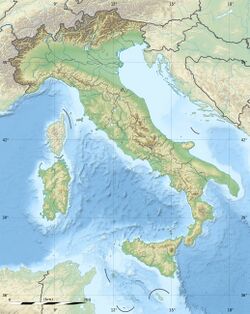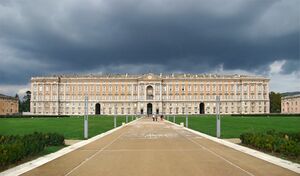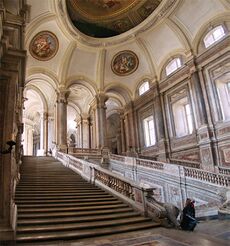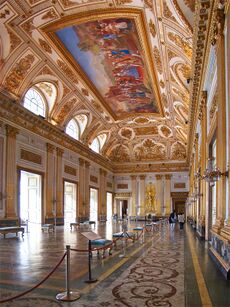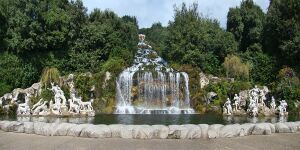قصر كاسرتا الملكي
| القصر الملكي في كاسرتا | |
|---|---|
| Reggia di Caserta | |
 منظر للواجهة الشمالية من نافورة فينوس وأدونيس | |
 | |
| الأسماء البديلة | Palazzo Reale di Caserta |
| معلومات عامة | |
| النوع | قصر |
| النمط المعماري | الباروك المتأخر والنيوكلاسيكي المبكر |
| الموقع | كاسرتا، إيطاليا |
| العنوان | فيالي دوهيت، 81100 كاسرتا CE، إيطاليا |
| Construction started | 1752 |
| التفاصيل التقنية | |
| الحجم | 247 × 184 × 36 مترًا (42 مترًا بما في ذلك السطح) |
| مساحة الطابق | ح. 138,000 square metres (1,490,000 sq ft)[1] |
| معلومات أخرى | |
| Number of rooms | 1,200 |
| الموقع الإلكتروني | |
| reggiadicaserta | |
| موقع تراث عالمي لليونسكو | |
| جزء من | القصر الملكي في كاسرتا في القرن الثامن عشر مع الحديقة، قناة مياه فانفيتيلي، ومجمع سان لوتشو |
| السمات | ثقافي: (i)، (ii)، (iii)، (iv) |
| مراجع | 549rev |
| التدوين | 1997 (21st Session) |
| المساحة | 87.37 ha (0.3373 sq mi) |
| منطقة عازلة | 110.76 ha (0.4276 sq mi) |
| الإحداثيات | 41°4′24″N 14°19′35″E / 41.07333°N 14.32639°E |
القصر الملكي في كاسرتا (إيطالية: Reggia di Caserta it؛ ناپولية: Reggia 'e Caserta nap) هو إقامة ملكية سابقة في كاسرتا، كامبانيا، على بعد 35 كيلومترًا شمال نابولي في جنوب إيطاليا، بُني من قبل أسرة بوربون-الصقليتين كإقامة رئيسية لهم كـ ملوك نابولي. يقع على بعد 35 كيلومترًا شمال مركز نابولي التاريخي، وهو أكبر قصر بُني في أوروبا خلال القرن الثامن عشر.[2] في عام 1997، تم تصنيف القصر كموقع تراث عالمي تابع اليونسكو؛[3] وتم وصفه في ترشيحه بأنه "الأغنية الأخيرة لفن الباروك الرائع، الذي استمد جميع الميزات اللازمة لخلق وهم الفضاء متعدد الاتجاهات".[2] يعد القصر الملكي في كاسرتا أكبر إقامة ملكية سابقة في العالم،[2][4] حيث تبلغ حجمه أكثر من 2 مليون م3[5] ويغطي مساحة تبلغ 47,000 م2[6] بمساحة طابقية تبلغ 138,000 متر مربع موزعة على خمسة طوابق للمبنى.[7]
التاريخ
The construction of the palace began in 1752[2] for Charles VII of Naples (later Charles III of Spain), who worked closely with his architect, Luigi Vanvitelli.[8] When Charles saw Vanvitelli's grandly scaled model for Caserta, it filled him with emotion "fit to tear his heart from his breast."[9] In the end, Charles never slept a night at the Reggia, as he abdicated in 1759 to become King of Spain.[8] The project was carried to only partial completion for Charles' third son and successor, Ferdinand IV of Naples.
The political and social model for Vanvitelli's palace was Versailles, which, though strikingly different in its variety and disposition, solved similar problems of assembling and providing for the king, court, and government in a massive building with the social structure of a small city, confronting a baroque view of a highly subordinated nature, la nature forcée.[10] This was part of the entire concept of the palace when Mario Gioffredo first proposed it in 1750. According to George L. Hersey, the proposal envisaged a palace "that was a virtual city, housing not just the court and king but all the main political and cultural elites of the kingdoms of Naples and Sicily - university, museum, library, cabinet bureaus, military high commands, and so on."[11]
Noted British art historian Anthony Blunt said the palace:
"...became the symbol of the new monarchy, and Vanvitelli's bold design brilliantly expresses this idea. The vastness of the scale. The vistas through open vestibules to the park, and the dramatically planned grand staircase are all evidence that Charles aimed at rivalling Versailles; but not a single element is directly borrowed from Louis XIV's palace, and Caserta has the great advantage over its model of having been planned as a whole by a single architect at a single moment, as opposed to the sometimes untidy agglomeration of elements which makes Versailles more picturesque but less harmonious."[8]
The population of Caserta Vecchia was moved 10 kilometres (6.2 mi) to provide a workforce closer to the palace. A silk factory at San Leucio was disguised as a pavilion in the immense parkland.
Another of the king's primary objectives was to have a magnificent new royal court and administrative center for the kingdom in a location protected from sea attack and distant from the revolt-prone and congested city of Naples. Troop barracks were housed within the palace to provide the king with suitable protection.
The Royal Palace of Madrid, where Charles had grown up, had been devised by Filippo Juvarra for Charles' father, Philip V of Spain, and Charlottenburg Palace provided models. A spacious octagonal vestibule seems to have been inspired by Basilica di Santa Maria della Salute in Venice, while the palatine chapel is most often compared to the Royal Chapel at Versailles. Vanvitelli died in 1773: the construction was continued by his son Carlo and then by other architects; but the elder Vanvitelli's original project, which included a vast pair of frontal wings similar to Bernini's colonnades at St. Peter's Square, was never finished.[12] In 1861, with the birth of the Kingdom of Italy, Savoyard officials surveyed the contents of the Palace. The bidet was inventoried as follows: "strange object in the shape of a guitar".[13]
From 1923 to 1943, the palace was the location of the Accademia Aeronautica, the Italian Air Force Academy. From 1943, during the allied invasion, the royal palace served as Allied Force Headquarters for the Supreme Allied Commander in the Mediterranean area; Sir Maitland Wilson, and later Sir Harold Alexander. In April 1945, the palace was the site of the signing of the unconditional surrender of German and Italian RSI forces in Italy. The agreement covered between 600,000 and 900,000 soldiers along the Italian Front, including troops in sections of Austria. The first Allied war crimes trial took place in the palace in 1945; German general Anton Dostler was sentenced to death and executed nearby, in Aversa.[14] In the left-hand arc behind the façade, a set of barracks was built. During World War II, the soldiers of the US Fifth Army recovered here in a "rest center." The palace continued as Allied Force Headquarters in 1946 under Britain's Gen. Sir William Duthie Morgan and in 1947 under American Lt. Gen. John C. H. Lee, each serving as Supreme Allied Commander, Mediterranean Theater of Operations, working to secure weapons and ordnance, restore infrastructure throughout the region, return refugees, and feed hundreds of thousands. The Theater was dissolved in September 1947. The palace was damaged by U.S. bombers in 1943, and was virtually emptied of furnishings during the war by looters. The Italian government took great pains to restore the building and return or replace decorations in keeping with the original pieces. Also, during World War II, Nazis occupied Caserta; therefore, the likelihood of them robbing the palace of pieces of its history is high.[15]
In 1998, the palace was a filming location for Star Wars: Episode I - The Phantom Menace, specifically as the interior of the Theed City Naboo Palace. It was used as a location for four days after it had been closed to visitors. Scenes with explosions were filmed on replica sets in Leavesden Studios in England to avoid damaging the actual palace. In addition, scenes from Star Wars: Episode II - Attack of the Clones were also filmed at the palace, specifically in the Upper Vestibule. [16]
The Royal Palace of Caserta has also been the site of other notable movies and tv series, such as The Great, Mission: Impossible III, Angels & Demons, Kaos, Conclave, Ferdinando and Carolina among others.[17]
Layout of the palace
"The palace has five floors; 1,200 rooms, including two dozen state apartments; 1,742 windows; 34 staircases; 1,026 fireplaces; a large library; and a theatre modelled after the Teatro San Carlo of Naples. A monumental avenue running 20 kilometers between the palace and Naples was planned but never realized."[18] [19]
The palace has a rectangular plan, measuring 247 × 184 m, and the four sides are connected by two orthogonal arms, forming four inner courts.
Even without the surface area of the internal courtyards, Caserta is by far the largest royal palace resulting from a single original project in the world in terms of volume, with more than 2 million cubic metres (70 million cubic feet).[20] The floor space is 138,000 square meters.[21] Behind the façades of its matching segmental ranges of outbuildings that flank the giant forecourt, a jumble of buildings arose to facilitate daily business. The palace encloses four courts that feature what scholars describe as a well-proportioned interior that evokes a monotonous dignity unique in its time.[22]
Of all the royal residences inspired by the Palace of Versailles, the Reggia of Caserta is the one that bears the greatest resemblance to the original model: the unbroken balustraded skyline and the slight break provided by pavilions within the long, somewhat monotonous façade. As at Versailles, a large aqueduct was required to bring water for the prodigious water displays. Like its French predecessor, the palace was intended to display the power and grandeur of an absolute Bourbon monarchy.[8] A solecism at Caserta is that above the piano reale, the King's floor, is another floor of equal magnificence. The enfilades of Late Baroque saloni were the heart and seat of government, as well as displays of national wealth. Caserta provided a royal refuge from the dust and factions of the capital, just as Versailles had freed Louis XIV from Paris. The royal palace has more than 40 monumental rooms completely decorated with frescoes when, in comparison, Versailles counts only 22 monumental rooms.[23]
The park
The garden, a typical example of the Baroque extension of formal vistas, stretches for 120 hectares, partly on hilly terrain.[24] Its construction started in 1753,[24] and it is also inspired by the park of Versailles. The park starts from the back façade of the palace, flanking a long alley with artificial fountains and cascades. There is a botanical garden called "The English Garden" in the upper part designed in the 1780s[24] by Carlo Vanvitelli and the German-born botanist, nurseryman, and plantsman-designer, John Graefer, who was trained in London and recommended to Sir William Hamilton by Sir Joseph Banks.[25] It is an early Continental example of an English garden in the svelte naturalistic taste of Capability Brown.
The fountains and cascades, each filling a vasca (basin), with architecture and hydraulics by Luigi Vanvitelli at intervals along a wide straight canal that runs to the horizon, rivalled those at Peterhoff Palace outside St. Petersburg. These include:
- The Fountain of Diana and Actaeon (sculptures by Paolo Persico, Angelo Maria Brunelli, and Tommaso Solari);
- The Fountain of Venus and Adonis (1770–80);
- The Fountain of the Dolphins (1773–80);
- The Fountain of Aeolus;
- The Fountain of Ceres.
Many figures from classical Antiquity were modelled by Gaetano Salomone for the gardens of the Reggia and were executed by large workshops.
Contemporary observers noted that the Caserta surpassed all other European royal palaces, including its models, in one particular aspect: the combination of completeness and stateliness.[26] This is attributed to the spacious oval piazza in front of the edifice's south side.
UNESCO World Heritage Site
The palace was listed as a UNESCO World Heritage Site in 1997.[27] According to the rationale, the palace, "whilst cast in the same mould as other 18th-century royal establishments, is exceptional for the broad sweep of its design, incorporating not only an imposing palace and park but also much of the surrounding natural landscape and an ambitious new town laid out according to the urban planning precepts of its time."[3]
مرئيات
| لماذا تم التخلي عن أكبر قصر ملكي في أوروبا (وترميمه) قصر كاسرتا. |
See also
References
- ^ مصدر البيانات: "La reggia della Meraviglia"، بإشراف أوتافيو راجون، كونشيتا سانينو وأنتونيو فيرارا، غيدا إيديتوري، 2022، الصفحة 19: "una superficie di 138 mila mq nei cinque piani fuori terra e 45.000 mq nei due interrati".
- ^ أ ب ت ث Chronopoulou, Angeliki (23 يناير 2024). "نظرة تاريخية على قصر كاسرتا". Academia (in إنجليزي). Retrieved 23 يناير 2024.
{{cite web}}: CS1 maint: unrecognized language (link) - ^ أ ب "18th-Century Royal Palace at Caserta with the Park, the Aqueduct of Vanvitelli, and the San Leucio Complex". UNESCO World Heritage Centre.
- ^ FERRAND, Franck (24 أكتوبر 2013). Dictionnaire amoureux de Versailles. Place des éditeurs. ISBN 9782259222679 – via Google Books.
- ^ "دليل القصر الملكي في كاسرتا، الصفحة 6، المربع: "أرقام قصر كاسرتا"". 13 يناير 2013.
- ^ "CampaniaBeniCulturali - Reggia di Caserta". 29 مارس 2012. Archived from the original on 19 أكتوبر 2014.
- ^ مصدر البيانات: "La reggia della Meraviglia"، بإشراف أوتافيو راجون، كونشيتا سانينو وأنتونيو فيرارا، غيدا إيديتوري، 2022، الصفحة 19: "una superficie di 138 mila mq nei cinque piani fuori terra e 45.000 mq nei due interrati".
- ^ أ ب ت ث Blunt, Anthony (April 1979). "Naples under the Bourbons, 1734-1805". The Burlington Magazine. 208 (913): 207–211. JSTOR 879556.
- ^ Wilson, Katherine (April 19, 2016). Only in Naples (1st ed.). Random House. p. 127.
- ^ Siegfried Giedion (1941) Space, Time and Architecture pp 133ff.
- ^ Hersey, George (2001). Architecture and Geometry in the Age of the Baroque. Chicago: University of Chicago Press. p. 119. ISBN 0226327841.
- ^ "Luigi Vanvitelli, The Architect of The Royal Palace of Caserta". Reggia Di Caserta Unofficial. 2014. Retrieved February 1, 2024.
- ^ Erminio De Biase, England against the Kingdom of the Two Sicilies: live and let die , 2002, p. 159.
- ^ Anthony Cave Brown (1984). The last hero: Wild Bill Donovan. Vintage Books. ISBN 978-0-394-72305-1.
- ^ "The Sad Story of The Furnishings of The Palace of Caserta". Reggia Di Caserta Unofficial. February 6, 2024.
- ^ "Star Wars movie locations". Visit World Heritage. February 6, 2024.
- ^ "Reggia in the Movies". Reggia Di Caserta. February 6, 2024.
- ^ Bruno, Nick (2013). Naples: Includes Pompeii, Vesuvius & Herculaneum Footprint Focus Guides. Footprint Travel Guides. p. 53. ISBN 978-1908206947.
- ^ "Capua & Caserta Day Tour". February 6, 2024.
- ^ Guiotto, Gianluigi (June 2009). La Reggia di Caserta. Capone Editore. ISBN 9788883491238 – via Issuu.
- ^ Source of datas: "La reggia della Meraviglia", curated by Ottavio Ragone, Conchita Sannino e Antonio Ferrara, Guida Editori, 2022, pag. 19: "una superficie di 138 mila mq nei cinque piani fuori terra e 45.000 mq nei due interrati".
- ^ Hamlin, A.D.F. (1897). History of Architecture. Biblo & Tannen Publishers. p. 309. ISBN 0819628735.
- ^ Sullivan, Kimberly (August 15, 2017). "Bigger than Versailles – the Royal palace at Caserta". Kimberly Sullivan Author. Retrieved February 6, 2024.
- ^ أ ب ت "Caserta Royal Palace and Parkes, Italy". Visit World Heritage. February 6, 2024.
- ^ Alice M. Coats, "Forgotten Gardeners, II: John Graefer" The Garden History Society Newsletter No. 16 (February 1972), pp. 4–7.
- ^ Laxton, William (1848). The Civil Engineer and Architect's Journal, Volume 11. London: R. Groombridge and Sons. p. 36.
- ^ "18th-Century Royal Palace at Caserta with the Park, the Aqueduct of Vanvitelli, and the San Leucio Complex". UNESCO World Heritage Convention. February 6, 2024.
Further reading
- Attlee, Helena (2006). Italian Gardens - A Cultural History (paperback). London: Frances Lincoln. pp. 240 pages. ISBN 978-0-7112-3392-8.
- Hersey, George. Architecture, Poetry, and Number in the Royal Palace at Caserta, (Cambridge: MIT Press) 1983. Caserta interpreted through the Neapolitan philosopher Giambattista Vico
External links
- Official website
- The reference website about the Palace of Caserta (hours, history, halls, park, the attractions in the Province, etc.) - Italian/English language
- In-depth site on the Royal Palace of Caserta in English, Spanish and Italian
خطأ لوا في وحدة:Authority_control على السطر 278: attempt to call field '_showMessage' (a nil value).
- Pages using gadget WikiMiniAtlas
- Short description is different from Wikidata
- Infobox mapframe without OSM relation ID on Wikidata
- Coordinates on Wikidata
- Articles containing إيطالية-language text
- Articles containing ناپولية-language text
- Official website different in Wikidata and Wikipedia
- Houses completed in 1752
- Palaces in Campania
- Royal residences in the Kingdom of Naples
- Buildings and structures in Caserta
- Art museums and galleries in Campania
- World Heritage Sites in Italy
- 1752 establishments in Italy
- Neoclassical palaces in Italy
- Neoclassical architecture in Campania
- Italian Baroque gardens
- Baroque palaces in Italy
- Baroque architecture in Campania
- Museums in Campania
- Historic house museums in Italy
- National museums of Italy
- 18th-century establishments in the Kingdom of Naples
- Luigi Vanvitelli buildings
- Charles III of Spain
- Ferdinand I of the Two Sicilies
- صفحات مع الخرائط
